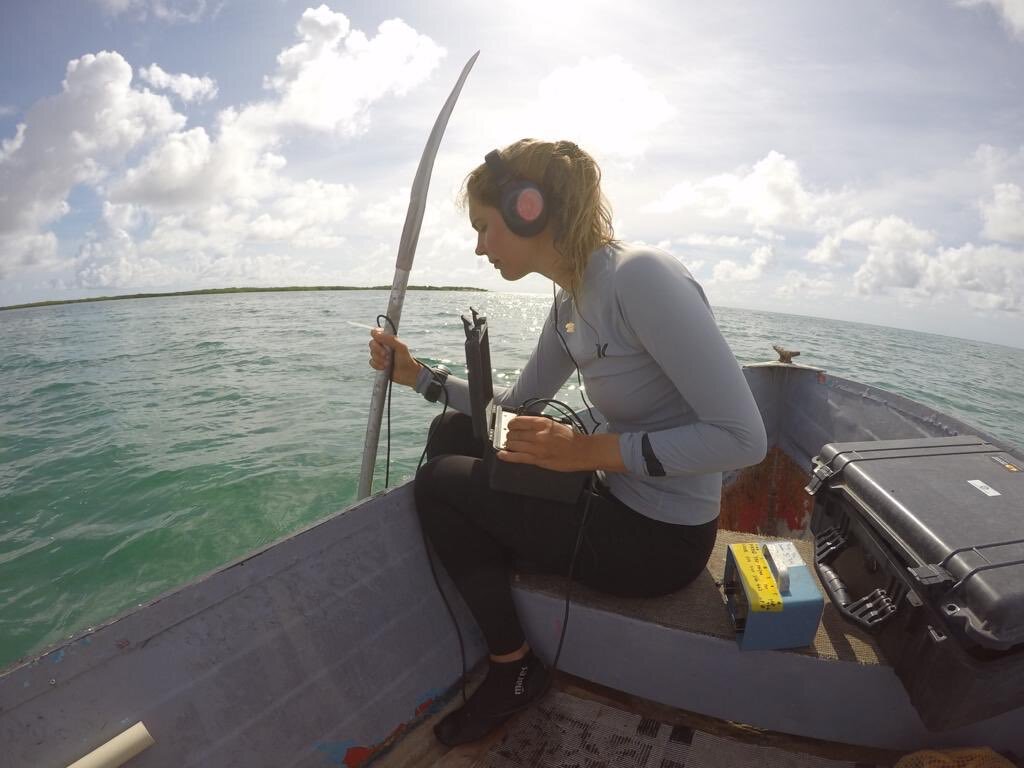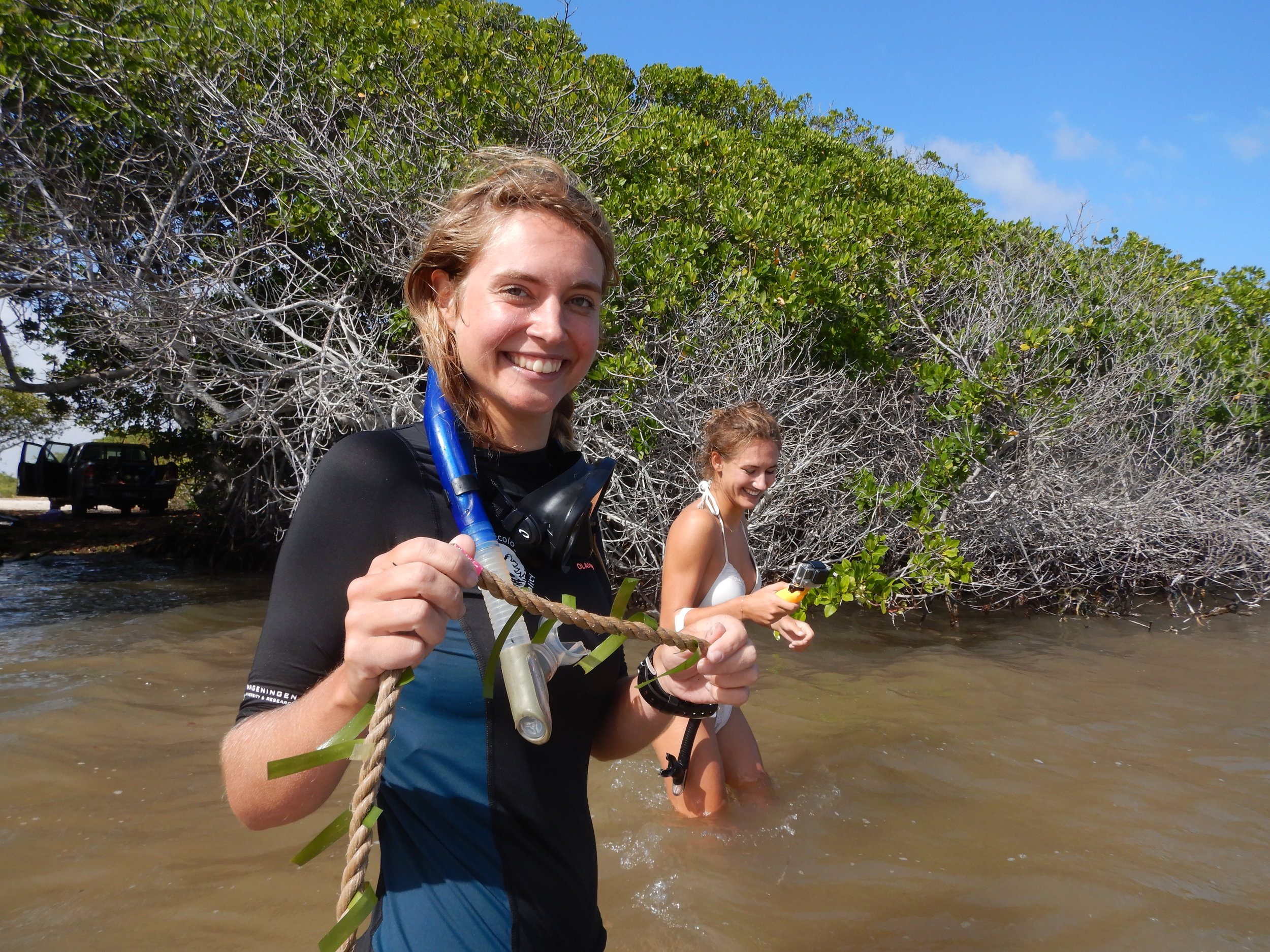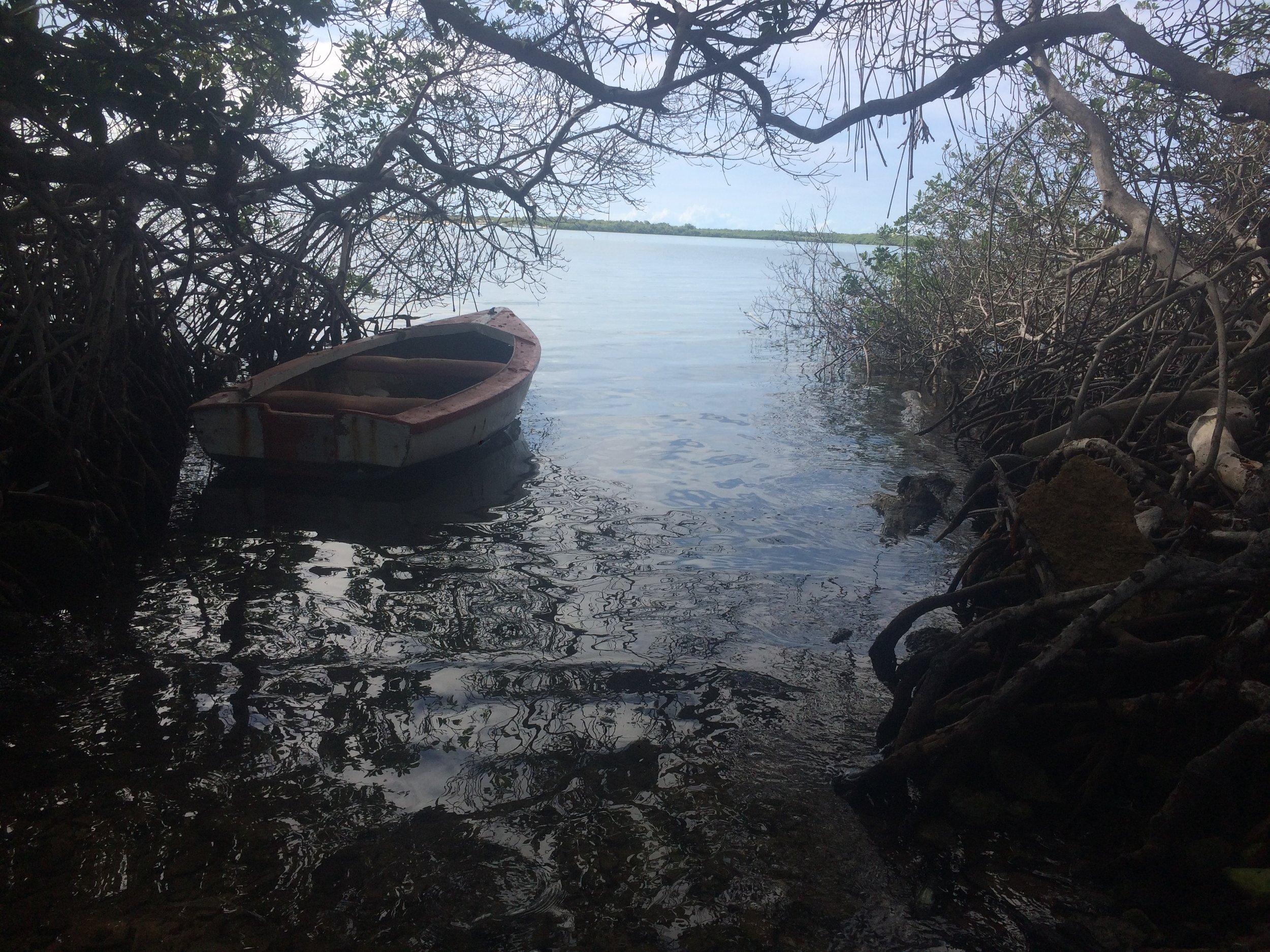
New paper on invasive seagrass flowers: male plants first to colonize new habitats?
Seagrasses are marine flowering plants that can reproduce both sexually (through flowering and subsequent seed formation) and asexually (through clonal growth). Sexual reproduction increases genetic diversity, resilience and dispersal success of seagrasses.
The invasive seagrass Halophila stipulacea originating from the Red Sea and Western Indo-Pacific, has been successfully invading the Mediterranean Sea since 1894 and the Caribbean Sea since 2002.
In this new paper, we found that so far, only male flowers have been described of the successful invasive seagrass species H. stipulacea in the Caribbean Sea. Female flowers and fruits have not been reported. This means that fragmentation and fast clonal growth may be the only factors explaining its current success. This needs to be taken into account in further studies studying H. stipulacea expansion.
In-depth monitoring of reproductive structures in invaded seagrass meadows, both in the Mediterranean and the Caribbean Sea is important to assess further invasion potential. Given past misunderstandings regarding the identification of H. stipulacea reproductive structures, we have developed a field guide with a dichotomous key, to take into the field and identify the various structures by eye. https://doi.org/10.1515/bot-2020-0046
Follow-up turtle spy cameras on the Bahamas
Next up was Eleuthera, an island in the Bahamas. Here, we wanted to deploy cameras on sea turtles to look at grazing behaviour and predator interactions. Turtle predators such as tiger sharks are more abundant in the Bahamas compared to the Dutch Caribbean, and therefore we are interested in how this impacts turtle grazing behavior. However, on Bonaire, we were unsuccessful in finding our cameratags back. So we had to search for an alternative way of retrieving our cameratags, after they are automatically released from the turtle. We decided to try out GPS trackers, bought at Spy Spot Investigations in Miami.
We had one morning in Miami in transit to Eleuthera and very very last-minute managed to buy the trackers. Then we had to reshape our cameratag-design to fit the tracker and for the device to fit on smaller turtles. We bought local simcards on Eleuthera and hoped that this method would provide us with real time locations of the package
We captured the turtles in the morning and attached the camera devices to their carapaces. The cameratag including the GPS tracker in custom-made waterproof yellow packaging is shown on the left.
The next morning, we used the app provided with the GPS tracker to locate the floating package. We saw the trajectory, and where it washed ashore. This way, by boat, we could easily retrieve the cameratag the next day. This was way easier than our previous method, and we managed to deploy and retrieve 5 more cameras during our week on Eleuthera. On the camera footage, we saw turtles grazing on seagrass in various habitats: this data is very valuable to us and will be analyzed further. Additionally, we want to try out this new method on Bonaire as well and hope to increase our sample size.
We had memorable field week filled with trial and error, long hours and nightly boat rides, but overall we are very happy with our results, thanks to this great team!
Gallery with pictures (click-through) to get an impression of our work (including a lot of seagrass work now unmentioned) this week
And then sadly it was time to leave the island again! Eleuthera was an amazing experience, the island is beautiful and it’s very nice to compare the seagrass ecosystem here to the one on Bonaire. We learned a lot and go back with lots of data to be analyzed at Wageningen University and research. Stay tuned for updates.
Underwater construction and pilot with turtle-mounted camera’s
Oct/Nov 2019: Time for one of the craziest fully packed fieldwerk trips I’ve ever been on!
Firstly, I went to Bonaire with 4 students, where we worked really hard to set up a new turtle exclosure experiment, a fish exclosure experiment and a bioturbation experiment. We had a great team and worked for long days and spend many hours underwater.
For our experiments, we’re investigating top down and bottom up impacts of nutrients and fish and turtle grazing on native and invasive seagrass growth and ecosystem services. The students got introduced to scientific diving and quickly developed their underwater construction skills.
We took seagrass samples, processed them and I tried to transfer all my knowledge of relevant seagrass research methods. We also built baited remote underwater video stations to investigate shark presence, behavior and diversity on Bonaire.
Then it was time for the second stage of our trip: to see if we could fit these camera tags on green turtles foraging in Lac Bay, Bonaire, to find out more about their grazing preferences and behavior within the bay. Marjolijn arrived from the Netherlands to help, and we were good to go!
The next day we fitted our first turtle with a cameratag, in collaboration with sea turtle conservation Bonaire. The method seemed succesfull and the camera stayed on nicely and the turtle seemed not to mind by observation after release. Tags were programmed to release after 20 hours.
However, finding back the cameratags proved to be incredibly difficult. Our retrieval equipment did not work as expected, and several times our boat broke down. After searching for days we only found back 1 of our tags, and then it was time to go to our next destination…
Twitter updates from our current fieldtrip
By clicking on the images you get directed to some of our fieldwork pictures and updates
KNAW Ecology grant 2019
We’re super happy that the KNAW (Royal Netherlands Academy of Arts and Sciences) Ecology fund was awarded for our project. Now I can extend my fieldwork to go to the Bahamas, and other islands in the Caribbean. We will use this grant to answer questions concerning the impact of tropicalization on marine plant-herbivore interactions. Thank you KNAW! (for more info: https://www.knaw.nl/nl/prijzen/toekenningen-fondsen-knaw/toekenningen-knaw-fonds-ecologie-2019)
Video about our seagrass work online
Marjolijn and I assembled footage of our seagrass fieldwork in the Caribbean, and Marjolijn edited the images to display on the website of our department Aquatic Ecology of Wageningen university. See below!
Bonaire fieldtrip January 2019
This year kicked off with a 5 week fieldwork trip to Bonaire.
Already 8 months had passed since we started our fish exclusion experiment that’s part of a region wide experimental network. The 8mo sampling moment included taking pictures of the experimental plots, assessing shoot densitities and productivity in each of the 50 plots and burying a total of 100 teabags to measure decomposition rates in the sediment. We spend a lot of time underwater and in the ‘lab’(=our apartment) and concluded the work in one week with the three of us: Olivier our field assistant, Julia Msc student of Utrecht and me.
Next up was maintenance and monitoring of our turtle exclosures, and the start of a few pilot studies, including an aquarium or mesocosm experiment.
Another large part of this field trip was conducting the seagrass monitoring of Lac Bay.
Eight times we went out with the boat and in total visited 49 GPS points in the Bay, that are revisited once every two years. We assessed seagrass presence in different parts of the bay, and we use this data to follow the expansion of the invasive seagrass throughout the bay.
Last but not least, we had a visit of my chairgroup Aquatic Ecology and Water Quality Management of Wageningen University & Research. The group had a full program for five consecutive days. They visited the key ecosystems on the island and addressed several issues. We talked among others about the impact of overgrazing by goats and donkeys on erosion and subsequent coral degradation, the impact of increasing tourist pressure on marine ecosystems, mangrove expansion into Lac Bay and pollution in coastal waters by sewage/landfills/plastic. We used the broad knowledge of the group to brainstorm and discuss several key problems and possible solutions. This week inspired me to think in long-term concepts concerning research and nature conservation on Bonaire, and to broaden my scope to various issues. I particularly enjoyed conducting research on the reef (for the first time since 2015) and on land and combining those activities. Once again I was reminded of the importance of research communication and our obligation to do so.
Thanks to Stinapa for supporting us throughout this fieldtrip with logistics (boat use) and knowledge, they are of great help for researchers on Bonaire.
Collaboration with CORE education & research institute
I’m very excited to announce that next week I will be heading to Eleuthera, the Bahamas, for a field expedition. We have come in contact with CORE institute (www.coresciences.org), a fellow partner of the Thalassia Experimental Network, and we will set up additional experiments investigating the impact of turtle grazing on seagrass resilience. Thanks to the Alberta Mennega stichting for funding this field trip, which will provide valuable insights into marine plant-herbivore dynamics.
Updates will follow!
Video still by Owen O’Shea
Fieldtrip September 2018
This September, we (Marjolijn, me and masterstudent Mark) went to Bonaire for three weeks of fieldwork. During this time, we monitored our experiment that is part of the Thalassia Experimental Network (together with Justin Campbell of the Smithsonian Institute). We performed productivity measurements and harvested several shoots per plot for morphological analysis.
Additionally, we set up a large number of new plots to investigate effects of nutrient addition and turtle grazing on seagrass resilience and ecosystem services. This research will provide new insights in invasive species mechanisms and differences in ecosystem services provided between seagrass species. This project will provide nice opportunities for several masterstudents to conduct their internship in the Caribbean.
Special thanks to Budget car rental Bonaire for supporting our fieldtrip!



































































